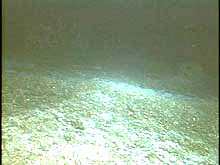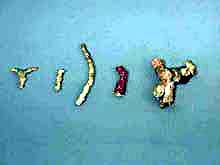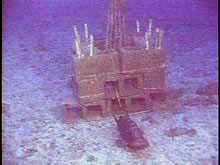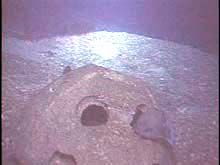
Much of Oculina Banks now looks like this. Dead Oculina coral fragments, the dark material on the bottom, are strewn about as rubble. Scientists are attempting to restore Oculina habitat at this site on Sebastian's Reef. Note the reef ball in the distance (far right just beyond the illuminated area), which was placed there as a potential substrate for the coral and to simulate fish habitat. Click image for larger view.
Coral Reef Restoration
September 2, 2001
Chris Koenig
Research Marine Ecologist
Department of Biological Sciences
Florida State University
![]() View a video of reef balls, which are being used to restore the coral growth and re-establish fish habitat. (5.6 MB, QuickTime
View a video of reef balls, which are being used to restore the coral growth and re-establish fish habitat. (5.6 MB, QuickTime ![]() required).
required).
Background
In 1975. scientists from the Harbor Branch Oceanographic Institution (HBOI) used manned submersibles to dive on the Oculina Bank area and discovered the coral community there. At the time, many of the pinnacles and ridges of the 300-sq-nm Banks teemed with grouper, snapper, and amberjack in dense stands of ivory tree coral (Oculina varicosa). By the early 1990s, however, the fish populations dwindled severely, and most of the coral habitat had been destroyed.
The scientists who discovered the banks recognized the fragile nature of the coral and its significance to the most important reef fishery species in the South Atlantic, gag and scamp grouper. By 1984, they convinced the South Atlantic Fisheries Management Council (SAFMC) to designate 92 sq nm -- about one-third of the bank -- as a Habitat Area of Particular Concern (HAPC). In 1994, the SAFMC declared the same area an experimental research reserve, where, for the next 10 yrs, trawling, dredging, and bottom fishing would be prohibited.

Oculina coral fragments at different stages of decay. The piece on the left has been dead for a short time; the round calyx structures, where coral polyps attach, are still visible. The next two pieces (second and third from the left) have been dead longer, perhaps six months to a year, and are beginning to show signs of colonization by other reef animals. The two pieces on the right have probably been dead for 1-2 yrs. They are heavily encrusted and discolored by tube worms, sponges, and other boring organisms. Click image for larger view.
When we dove on the Banks in 1995 to study the fish populations, one scientist who had discovered the Banks was stunned by the destruction of the Oculina habitat since observing it in the 1970s, prior to a period of intense bottom trawling for shrimp and scallops. Naturally, we wondered whether the coral's destruction and failure to reproduce were linked to this activity or to some natural phenomenon. With knowledge of this broad- scale loss of Oculina habitat, the SAFMC made restoring the habitat the highest priority.
An Experiment with Reef Balls
For the next six years, we experimented with reestablishing the Oculina corals. Originally, we wanted to test whether living Oculina could survive if we put it anywhere in the reserve, and whether it could settle and grow on a clean concrete surface. For three years, beginning in 1996, we deployed 56 sets of concrete-block clusters, or reef balls, throughout the reserve, in hopes of restoring the Oculina and simulating its habitat. About half of the reef balls were set out with coral attached, and the other half were bare. When we returned to look at the reef balls in 1999, we discovered that on the ones where coral remained attached, the coral was alive. On some blocks, the coral appeared to have been stripped off. Of the balls set out without attached coral, only one showed coral recruitment.

These concrete blocks were the first artificial structures deployed to provide a substrate for reestablishing Oculina coral and simulating fish habitat on Oculina Bank. Click image for larger view.
In 2000, we decided to deploy commercially available, dome-shaped reef balls about 3 ft in diameter with holes for the fish to swim through. Their shape actually resembles an Oculina coral head. We dropped these off a stationary ship in three sets of 5, 10, and 20 reef-ball clusters (a total of 105 reef balls), all with Oculina coral attached. (![]() Watch a short video that shows three of these deployed reef balls.)
Watch a short video that shows three of these deployed reef balls.)
Near each cluster of reef balls, we also deployed 25 patio stones, each with a small fragment of Oculina attached to a single PVC pipe fastened vertically to the center of the stone. This was an experiment to evaluate how small a fragment could survive and grow. We did this because the smaller the fragment that can survive, the less coral must be removed from donor sites to aid in restoration.

A speckled hind is about to enter one of the reef balls deployed at Sebastian's Reef in September 2000. Scientists are encouraged by their observations of more fish at the reef-ball sites during this leg of the Sustainable Seas Expeditions/Islands in the Stream South Atlantic Bight Mission. Click image for larger view.
An Apparent Initial Success
Yesterday, explorers descended to a depth of more than 300 ft in the Cleliasubmersible to search for the reef balls deployed last year. We found all of the sets, but not all of the reef balls in each set. From our vantage point in the Clelia it is still too early to tell how successful we have been in reestablishing Oculina, since it grows only about one-half inch per year. To our delight, however, it appears that we are in the initial stages of reclaiming this habitat for the fish that belong there. We observed that the reef balls have already been colonized by groupers, amberjacks, snappers, angelfish, butterflyfish, and small basses.
Sign up for the Ocean Explorer E-mail Update List.











































